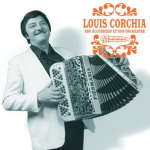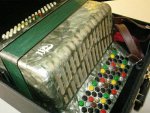M
maugein96
Guest
Thread starter
My memory isnt what it was. This is the example of the B system accordion I was thinking of, as played by Andre Verchuren.
The way the buttons are arranged is logical for B system, whereas the accordion played by Willy Staquet has a treble button arrangement that perhaps would suggest he actually played C system. However, Willy has been dead for a long time and the information I have is that he played Liegeois (or standard) B system, where B would be in the first row and C in the third.
With regard to both accordions, it must be said that neither of them is typical and it may have been the case that the treble buttons were arranged to the specifications of the players. I am aware that they both have Belgian basses.
It is sometimes the case with CBA that one or more treble buttons serve no purpose at all other than to make the arrangement look more symmetrical. These will naturally be buttons at the very top or bottom of the rows concerned. Ive never seen either Willy Staquet or Andre Verchuren play an instrument with anything other than monocoloured buttons, and in fact I can only think of one or two French players who use bicoloured treble buttons
The way the buttons are arranged is logical for B system, whereas the accordion played by Willy Staquet has a treble button arrangement that perhaps would suggest he actually played C system. However, Willy has been dead for a long time and the information I have is that he played Liegeois (or standard) B system, where B would be in the first row and C in the third.
With regard to both accordions, it must be said that neither of them is typical and it may have been the case that the treble buttons were arranged to the specifications of the players. I am aware that they both have Belgian basses.
It is sometimes the case with CBA that one or more treble buttons serve no purpose at all other than to make the arrangement look more symmetrical. These will naturally be buttons at the very top or bottom of the rows concerned. Ive never seen either Willy Staquet or Andre Verchuren play an instrument with anything other than monocoloured buttons, and in fact I can only think of one or two French players who use bicoloured treble buttons




